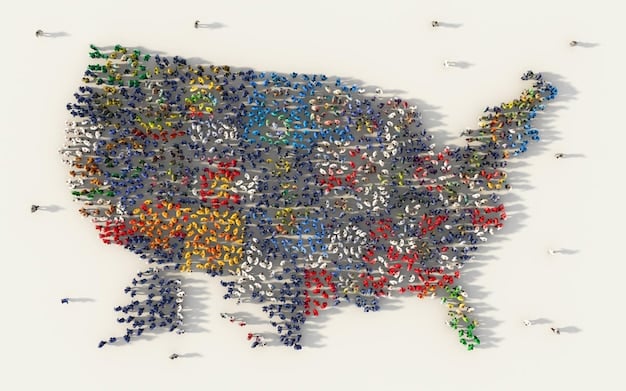US Census Data: Population Shifts and Political Power Revealed

The latest US Census data reveals dynamic population shifts across states, profoundly influencing the realignment of political power through congressional redistricting and electoral college vote allocation, reflecting changing demographic landscapes.
Understanding what does the latest US Census data reveal about population shifts and political power is crucial for comprehending the evolving socio-political landscape of the United States. This detailed demographic insight from the Census Bureau goes far beyond mere numbers; it serves as a critical barometer for congressional representation, electoral college dynamics, and the allocation of federal resources, embodying the very pulse of American governance and societal change.
Decoding the Delineation: Apportionment and Redistricting
The US Census, conducted every ten years, is far more than an academic exercise in demography; it is a constitutional mandate with profound implications for the nation’s political architecture. At its core, the census data directly informs the apportionment of seats in the House of Representatives among the states. This process, known as reapportionment, effectively re-calibrates each state’s proportional legislative influence based on its updated population count. Following this, states undertake the intricate and often contentious task of redistricting, drawing new congressional and state legislative boundaries.
These boundaries are not just lines on a map; they define the electoral battlegrounds, influencing who can vote for whom, and ultimately, which voices are amplified in Washington D.C. and state capitals. The interplay between population shifts and redistricting is a perpetual cycle of adaptation, where growth or decline in certain states necessitates a rebalancing of power to ensure equitable representation across the diverse American populace.
The Stakes of Reapportionment
Reapportionment dictates how many of the 435 available seats in the House of Representatives each state receives. A state’s gain in population relative to others can lead to an increase in its congressional delegation, while a relative decline means it might lose a seat. These shifts are consequential for several reasons.
- Congressional Clout: More representatives provide a state with greater voting power and a louder voice in federal legislative debates, committee assignments, and policy formulation.
- Electoral College Votes: A state’s number of Electoral College votes is the sum of its senators (always two, regardless of population) and its representatives. Therefore, changes in House seats directly impact a state’s weight in presidential elections.
- Federal Funding: Many federal funding streams, from infrastructure projects to social programs, are disbursed based on population data, amplifying the practical, everyday importance of an accurate count.
The strategic implications are immense, compelling political parties to meticulously analyze these shifts and strategize accordingly for future electoral cycles.
The precise calculations involved in reapportionment are governed by a complex mathematical formula designed to achieve the most equitable distribution possible. This process, while seemingly technical, often ignites intense political debate, as every seat gained or lost can alter the national balance of power for a decade. The raw numbers translate directly into concrete political capital, influencing everything from federal budget allocations to the national policy agenda.
Redistricting: The Battle for Boundaries
Once reapportionment is complete, each state with changes in its congressional delegation must redraw its district lines. This often hyper-partisan process, known as redistricting, determines the geographical and demographic composition of voting districts. The practice of “gerrymandering”—drawing district lines to favor one political party or group over another—is a recurring flashpoint, leading to numerous legal challenges and public outcry.
The implications of strategically drawn districts include:
- Electoral Outcomes: Gerrymandering can create safe seats for one party, reduce the competitiveness of elections, and significantly influence the partisan makeup of state legislatures and Congress.
- Representation Equity: Poorly drawn districts can dilute the voting power of minority groups or concentrate opposition votes into a few districts, minimizing their overall influence.
- Voter Engagement: When districts are perceived as unfairly drawn, it can lead to voter disenfranchisement and reduced participation, undermining the democratic process.
Recent technological advancements and sophisticated data analysis tools have made gerrymandering even more precise, enabling map drawers to identify and target specific demographic clusters with unprecedented accuracy. This has fueled calls for independent redistricting commissions to try and mitigate partisan manipulation.
In summation, the foundational role of the census in democratic governance cannot be overstated. From the initial statistical count to the final remapping of electoral districts, each step in this decennial process directly shapes the allocation of political power, impacting the lives of millions and setting the course for the nation’s future direction.
Population Migration: The Sun Belt’s Ascent and Rust Belt’s Retreat
The latest US Census data unequivocally illuminates a continuing trend of population migration, shaping the geographical distribution of American political influence. For decades, the narrative has been clear: the “Sun Belt” states in the South and West are experiencing robust population growth, largely at the expense of the “Rust Belt” states in the Midwest and Northeast. This sustained population shift holds significant implications for the political landscape.
States like Texas, Florida, Arizona, and North Carolina have been magnets for new residents, drawn by factors such as burgeoning job markets, lower costs of living, and favorable climates. This influx of people, often from more densely populated and higher-tax coastal areas, directly translates into increased political representation and economic vitality for these growing regions. Concurrently, states like New York, Illinois, Pennsylvania, and Michigan have seen a slower growth rate, or in some cases, even a decline in population, resulting in a proportional decrease in their federal political power. This demographic reordering is not just a statistical anomaly; it is a fundamental restructuring of America’s internal geography of power.

Why the Sun Belt Shines
Multiple factors contribute to the sustained appeal of the Sun Belt, driving both domestic and international migration:
- Economic Opportunities: Many Sun Belt states have fostered business-friendly environments, attracting major corporations and creating new job opportunities in tech, manufacturing, and other sectors.
- Affordable Living: Generally lower housing costs and property taxes, compared to traditional coastal hubs, make these regions more accessible for families and individuals.
- Climate and Lifestyle: Warm weather and a perceived higher quality of life, including access to outdoor activities, continue to be significant draws.
- Retirement Migration: A substantial portion of the aging American population seeks out warmer climates for retirement, further bolstering Sun Belt numbers.
The growth in these areas is not homogenous; it often concentrates in specific metropolitan areas, leading to rapid urbanization alongside continued rural flight in some traditional agricultural regions. This creates its own set of challenges related to infrastructure, resource management, and social services.
The economic dynamism of the Sun Belt is a key driver. States have actively pursued policies aimed at diversifying their economies beyond traditional sectors, investing in technology, renewable energy, and advanced manufacturing. These efforts have created a virtuous cycle, attracting talent and capital, and further solidifying their position as economic growth poles. The relative affordability, particularly in terms of housing, has also been a major draw for families and younger professionals seeking to establish roots.
Challenges for the Rust Belt
Conversely, many Rust Belt states grapple with legacies of deindustrialization, aging infrastructure, and a slower pace of economic diversification. While some cities within these regions have experienced revitalization, the broader trend has been one of stagnation or decline compared to the booming Sun Belt.
These demographic shifts directly impact the political power map:
- Loss of House Seats: States with declining or stagnant populations risk losing seats in the House of Representatives, diminishing their voice in Congress.
- Reduced Electoral College Influence: Fewer House seats mean fewer Electoral College votes, making these states less pivotal in presidential elections.
- Policy Implications: The changing demographics can shift legislative priorities, as the needs and concerns of growing states increasingly dominate the national agenda.
However, it’s important to note that population dynamics are complex. Some Rust Belt states are actively working to reverse these trends, investing in urban renewal, tech hubs, and initiatives to retain and attract younger populations. While the broad stroke of migration favors the Sun Belt, localized successes and nuanced internal shifts are always at play. Understanding these forces is essential for any analysis of the future of American political alignment.
The challenges faced by many Rust Belt states are multifaceted, rooted in historical economic transformations, but also in ongoing issues such as infrastructure deficits and a relatively high tax burden compared to their Southern counterparts. While some urban centers are experiencing a renaissance driven by tech and culture, these localized successes often do not offset the broader demographic trends across the state. This creates a political dichotomy where the concerns of legacy manufacturing communities might differ significantly from those of burgeoning tech hubs within the same state, influencing both internal and national political discourse.
Demographic Shifts: Age, Ethnicity, and Political Realignment
Beyond broad regional migration, the latest US Census data provides granular insights into shifts in age, ethnic, and racial compositions across the nation. These demographic transformations are not merely statistics; they are drivers of profound political realignment, shaping voter preferences, policy debates, and the very identity of America’s political parties. The increasing racial and ethnic diversity, coupled with an aging population, presents both opportunities and challenges for political leaders and policymakers.
The non-Hispanic white population, while still the largest group, is declining as a percentage of the total population, while Hispanic/Latino, Asian, and multiracial populations are growing at faster rates. This diversification is profoundly reshaping the electorate, particularly in historically homogeneous states and regions. Concurrently, the overall median age of the US population continues to rise, indicating an aging demographic that has distinct political preferences and concerns, especially regarding healthcare, Social Security, and fiscal policy. These interwoven demographic trends are generating complex political crosscurrents that defy simple categorization, leading to a more nuanced and dynamic political landscape than ever before.
The Shifting Racial and Ethnic Landscape
The diversification of the American populace is one of the most salient takeaways from recent census data. The growth of Hispanic/Latino communities, driven by both immigration and birth rates, has been particularly noteworthy, establishing this group as the largest minority population. Asian Americans also represent a rapidly growing segment, with diverse origins and socio-economic profiles. These shifts are having a direct impact on electoral politics:
- Electoral Coalition Dynamics: Both major political parties are actively trying to court these growing demographic groups, leading to re-evaluations of traditional outreach strategies and policy platforms.
- Emerging Swing States: States previously considered reliably red or blue are becoming more competitive as their demographic compositions change, creating new battlegrounds for political contests.
- Policy Focus: Issues such as immigration, language access, and racial justice are gaining prominence in political discourse, reflecting the evolving concerns of a more diverse electorate.
The impact extends beyond national elections, influencing local legislative bodies and school boards, where issues of cultural representation and equity are increasingly debated. The political implications are felt most acutely in states where these demographic shifts are most pronounced, often leading to a re-evaluation of long-held political assumptions and power structures.
The growing racial and ethnic diversity in the United States is prompting a significant rethink in political strategy. Traditional assumptions about voter blocs are being challenged as new demographic segments exert their influence. This means political campaigns are forced to craft more inclusive messages and address a wider array of issues, moving beyond binary appeals. The rise of multiracial identities further complicates an already intricate puzzle, suggesting that simple demographic definitions are increasingly inadequate for understanding the nuances of the modern American electorate.
An Aging America: Implications for Policy
An equally important demographic trend is the aging of the US population. As the Baby Boomer generation enters retirement, and birth rates remain relatively low, the median age continues to climb. This aging demographic possesses significant political power due to consistently high voter turnout rates. Their concerns often revolve around issues critical to economic stability and quality of life in later years:
- Healthcare Costs: As the population ages, demand for healthcare services and prescription drugs increases, putting pressure on Medicare and other health programs.
- Social Security Solvency: Discussions around the long-term viability of Social Security become more urgent as the ratio of retirees to active workers shifts.
- Taxation and Fiscal Policy: Older voters often prioritize fiscal conservatism and stability, influencing debates on government spending and debt.
The balancing act for policymakers is to address the needs of an aging population while also investing in the future for younger generations. This demographic reality necessitates proactive policymaking to ensure the sustainability of social safety nets and to foster intergenerational equity in resource allocation. The interplay of these forces ensures that demographic data is not merely a record of the past but a powerful predictor of future political and social trajectories.
The confluence of an aging population and increasing diversity creates a complex political dynamic. For instance, younger, more diverse populations might prioritize issues like climate change or student loan debt relief, while older demographics might focus on healthcare and retirement benefits. Bridging these generational and cultural divides is a growing challenge for political parties seeking to build broad-based coalitions. The census data, by illuminating these demographic fault lines, provides a roadmap for understanding the evolution of America’s political landscape.
Economic and Social Impacts: Beyond the Ballot Box
The reverberations of population shifts extend far beyond congressional chambers and electoral maps; they profoundly influence the economic landscape and social fabric of communities nationwide. The latest US Census data offers a critical lens through which to examine these broader impacts, revealing how demographic changes shape local economies, infrastructure needs, and the distribution of resources. Understanding these multifaceted consequences is essential for comprehensive planning and policy development at both the state and local levels.
As populations migrate, they bring with them changing consumption patterns, labor force dynamics, and demands on public services. Growing areas face challenges related to housing affordability, traffic congestion, and strain on utilities, while declining regions grapple with shrinking tax bases, underutilized infrastructure, and the potential for reduced public services. These shifts also affect the diversity of local communities, impacting everything from school demographics to the types of businesses that thrive. The census data, therefore, serves as a vital tool for assessing these socioeconomic shifts, enabling communities to adapt and plan for a future shaped by evolving demographic realities.
Resource Allocation and Infrastructure Demands
Population changes directly impact the allocation of federal funding for a vast array of programs, from education to transportation. This means states and localities experiencing growth may qualify for more federal aid, enabling them to invest in necessary infrastructure expansion. Conversely, areas with population decline might see their federal funding decrease, creating fiscal strain:
- Transportation: Growing cities require new roads, public transit systems, and airport expansions to accommodate more commuters and travelers.
- Housing: An influx of residents drives demand for housing, often leading to rising home prices and rental costs, which can exacerbate affordability crises.
- Education: Shifting populations necessitate changes in school planning, including the construction of new schools in growing areas and potential consolidation or closure in areas with declining student enrollment.
- Healthcare: Demand for hospitals, clinics, and healthcare professionals scales with population size and age demographics.
The challenge for policymakers lies in anticipating these demands and ensuring that resources are strategically deployed to maintain a high quality of life for all residents, regardless of their community’s growth trajectory. The accuracy of census data is paramount here, as it underpins equitable distribution and effective long-term planning.
Labor Markets and Economic Vitality
Population shifts also have profound implications for local and regional labor markets. Growth regions often experience tight labor markets, driving up wages and creating opportunities, but also leading to skill shortages in certain sectors. Declining regions, on the other hand, may face persistent unemployment or underemployment, coupled with an aging workforce:
- Workforce Composition: In-migration brings diverse skills and perspectives, while out-migration can lead to a loss of young talent and an increasingly older workforce.
- Industry Adaptation: Communities must adapt their economic strategies to either attract the industries that align with new demographic profiles or diversify to retain existing populations.
- Entrepreneurship: Growing populations often foster a more vibrant entrepreneurial ecosystem, driven by new demand and a larger talent pool.
The census data provides the empirical basis for understanding these shifts, enabling businesses to make informed investment decisions and governments to tailor workforce development programs. This interplay of demographic change and economic response is a continuous cycle, shaping the prosperity and resilience of American communities for generations to come. The census is therefore not just a snapshot, but a vital predictive tool for socio-economic forecasting.
Challenges and Controversies: Data Accuracy and Political Stakes
The process of collecting, analyzing, and applying US Census data is never without its challenges and controversies. Given its profound implications for political power and resource allocation, the census is frequently at the nexus of intense political debate and technical scrutiny. Issues surrounding data accuracy, particularly concerning undercounts in hard-to-reach populations, and the politicization of certain demographic questions, underscore the complexities inherent in this constitutionally mandated undertaking.
Ensuring an accurate count is paramount, as even minor discrepancies can have significant ripple effects on representation and funding over the ensuing decade. However, various factors can impede this accuracy, from language barriers and distrust of government to logistical hurdles in surveying remote or transient communities. Moreover, recent years have seen heightened political tensions surrounding the census, with debates over citizenship questions and funding levels often mirroring broader partisan divides. These challenges highlight that the census is not merely a statistical exercise, but a deeply embedded political instrument whose integrity is constantly under watch.
Undercounts and Data Gaps
A persistent challenge in every census is the risk of an undercount, where certain segments of the population are missed. Historically, such undercounts disproportionately affect:
- Racial and Ethnic Minorities: Often due to language barriers, housing instability, or distrust of government institutions.
- Young Children: They are frequently overlooked in household counts or mistakenly omitted by caregivers who might not consider them primary residents.
- Low-Income Households: These communities may face mobility issues, lack of stable addresses, or limited access to internet for online responses.
- Immigrant Communities: Fear of deportation or lack of understanding about the census purpose can deter participation.
An undercount means these populations are underrepresented in Congress and receive fewer federal resources, perpetuating inequities. Census officials employ various strategies, including extensive outreach campaigns and community partnerships, to mitigate these gaps. Yet, the challenge remains formidable, emphasizing the need for robust funding and politically neutral execution.
The digital divide also plays a role, with some populations having limited access to the internet, which can impede their ability to complete online census forms. This puts a greater burden on traditional enumeration methods, such as door-to-door visits, which face their own set of logistical and safety challenges. The goal of a full and accurate count is critical, as it underpins the fairness and legitimacy of democratic representation.
Politicization of the Census
The census has, at times, become a battleground for political power. Debates surrounding the inclusion of a citizenship question, for example, have raised concerns about potentially discouraging participation from immigrant communities, leading to an undercount that could shift political power. Furthermore, funding for the Census Bureau itself can become a partisan issue, with implications for its ability to conduct a thorough and accurate count.
Such controversies undermine public trust and can politicize an exercise that is fundamentally about objective data collection. The stakes are immense:
- Faith in Institutions: If the public perceives the census as manipulated or inaccurate, it can erode trust in government statistics and democratic processes.
- Fair Representation: Any deliberate attempt to skew the count for political gain directly threatens the principle of “one person, one vote” and equitable representation.
- Resource Equity: Flawed data can lead to misallocation of billions of dollars in federal funds, adversely impacting communities that rely on these resources for essential services.
Ultimately, the integrity of the census hinges on its ability to remain an objective and non-partisan undertaking. Public confidence and broad participation are essential for securing an accurate count that faithfully reflects the nation’s changing demographics, ensuring that political power and resources are distributed fairly and justly among all Americans. The census is more than just numbers; it is a mirror reflecting who we are as a nation, and any distortion of that reflection has profound implications.
Future Outlook for US Demographics and Politics
Looking ahead, the latest US Census data not only captures a snapshot of current demographic trends but also provides invaluable insights into the likely trajectory of American population shifts and their continued influence on the nation’s political landscape. The patterns of regional migration, increasing diversity, and an aging populace are not sudden anomalies but rather deeply entrenched trends that are expected to persist and even accelerate in the coming decades. This means that the political and socio-economic consequences of these shifts will become even more pronounced, shaping policy debates, electoral strategies, and the very identity of American governance for the foreseeable future.
Anticipating these changes allows for proactive planning, enabling communities and political institutions to adapt to new realities rather than simply reacting to them. However, it also highlights potential future flashpoints, especially debates surrounding immigration policy, urban versus rural divides, and intergenerational equity. The census data, therefore, serves as a demographic compass, guiding discussions about the future of the American experiment and ensuring that democracy evolves in sync with its changing population.
Continued Regional Realignment
The outflow from the Northeast and Midwest towards the Southeast and Southwest is projected to continue, reinforcing the political ascendance of the Sun Belt. This sustained shift will likely lead to further reapportionment of congressional seats and Electoral College votes in favor of these growing regions. Consequently:
- Increased Political Clout: Sun Belt states will command a larger share of federal legislative power and become even more critical battlegrounds in presidential elections.
- New Policy Priorities: Their specific needs—such as water management, rapid urbanization, and infrastructure development—may increasingly dominate the national agenda.
- Shifting Party Power Bases: Both Democrats and Republicans will intensify their efforts to build and solidify support in these dynamically evolving regions.
This ongoing demographic rebalancing will necessitate a strategic rethinking for both political parties, requiring them to adapt their messages and outreach efforts to resonate with the diverse and growing populations in these burgeoning areas.
Growing Diversity and its Political Reflections
The United States will continue its inexorable march towards becoming a “majority-minority” nation, with profound implications for political representation and identity. The growth of Hispanic/Latino, Asian, and multiracial populations will increasingly diversify the electorate, making their voices indispensable in shaping election outcomes. This trend is expected to:
- Reshape Voting Coalitions: Political parties will need to construct broader and more inclusive coalitions, moving beyond traditional demographic pigeonholes.
- Elevate New Issues: Issues important to diverse communities, such as immigration reform, equitable access to education and healthcare, and anti-discrimination policies, will gain greater prominence.
- Foster New Leadership: The rising diversity will likely be reflected in an increasingly diverse set of elected officials at all levels of government, bringing new perspectives to policymaking.
This demographic transformation demands an adaptive political system that can effectively represent the myriad experiences and aspirations of an increasingly pluralistic society. The challenge lies in ensuring that this growing diversity translates into meaningful political participation and equitable outcomes.
The Persistent Influence of an Aging Population
The aging of the American population is a demographic force that will continue to shape political discourse, particularly concerning fiscal policy and social safety nets. As the proportion of older citizens grows, issues like Medicare, Social Security, and long-term care will remain high on the legislative agenda. This will require:
- Intergenerational Compromise: Policymakers will face ongoing pressure to find solutions that address the needs of seniors without unduly burdening younger generations.
- Healthcare Innovation: Continued focus on healthcare reform and technological advancements to manage rising costs and improve elder care.
- Workforce Adaptation: Strategies to extend working lives and adapt workplaces to an older workforce will become critical.
In conclusion, the latest US Census data provides not just a statistical summary of the recent past but a vital blueprint for understanding the future. The confluence of regional migration, increasing diversity, and an aging populace will continue to redefine American political power, requiring adaptability, foresight, and a commitment to equitable representation from all stakeholders.
| Key Insight | Brief Description |
|---|---|
| 📊 Population Shifts | Sun Belt states gain population and political influence, while Rust Belt states experience relative decline. |
| 🗳️ Political Reapportionment | Census data directly redetermines congressional district allocation and Electoral College votes per state. |
| 🌐 Demographic Diversity | Increasing ethnic and racial diversity is reshaping electoral coalitions and policy priorities nationwide. |
| 👵 Aging Population | An aging populace impacts social safety nets and fiscal policy, emphasizing healthcare and retirement issues. |
Frequently Asked Questions
▼
Census data directly affects political power by determining the number of seats each state holds in the House of Representatives. This process, called reapportionment, affects federal funding allocations and dictates the number of Electoral College votes a state receives in presidential elections, fundamentally reshaping its influence.
▼
The “Sun Belt” refers to states in the South and Southwest. It is gaining population due to factors like booming job markets, lower costs of living, favorable climates, and attraction for retirees, drawing residents from other regions and increasing its political significance.
▼
An aging population impacts US politics by increasing demand for healthcare and social security, influencing fiscal policies and budget priorities. This demographic group often has high voter turnout, making their concerns, such as Medicare and retirement benefits, central to political discourse.
▼
Main challenges include undercounting traditionally hard-to-reach populations like racial minorities, young children, and low-income households due to language barriers, distrust, or unstable living situations. Politicization, questions about citizenship, and funding levels can also compromise data accuracy and public trust.
▼
Redistricting directly influences election outcomes by redrawing electoral boundaries. This process can be manipulated through gerrymandering to create “safe seats” for a party, dilute the voting power of minority groups, or reduce the competitiveness of elections, thereby shaping the partisan makeup of legislative bodies.
Conclusion
The latest US Census data serves as an indispensable compass for understanding the profound reconfigurations occurring within the American socio-political landscape. The pervasive shifts, from the sustained population surge into the Sun Belt to the escalating ethnic diversity and the steady aging of the populace, are not just statistical curiosities but fundamental drivers of change. These demographic currents directly recalibrate congressional representation, influence presidential election dynamics through the Electoral College, and dictate the allocation of vital federal resources, thus shaping policy and impacting lives across the nation. The ongoing scrutiny of data accuracy and the underlying political controversies underscore the critical importance of this decennial exercise. As these trends continue to unfold, the census data provides both a reflection of America’s past and a powerful predictive tool for navigating its future, underscoring the imperative for adaptive governance and inclusive representation in a continuously evolving society.





